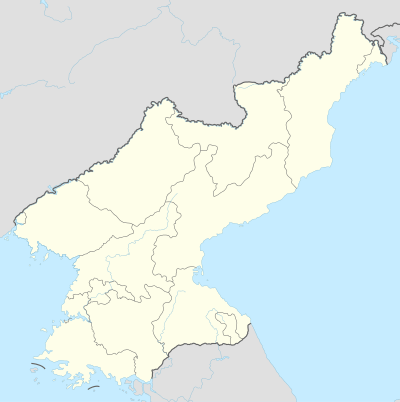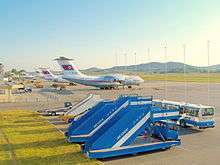Pyongyang Sunan International Airport
| Pyongyang Sunan International Airport | |||||||||||||||
|---|---|---|---|---|---|---|---|---|---|---|---|---|---|---|---|
 | |||||||||||||||
.jpg) | |||||||||||||||
|
IATA: FNJ – ICAO: ZKPY – WMO: 47058 | |||||||||||||||
| Summary | |||||||||||||||
| Airport type | Public | ||||||||||||||
| Owner | North Korean government | ||||||||||||||
| Serves | Pyongyang, North Korea | ||||||||||||||
| Location | Sunan District, Pyongyang, North Korea | ||||||||||||||
| Hub for | Air Koryo | ||||||||||||||
| Elevation AMSL | 36 m / 118 ft | ||||||||||||||
| Coordinates | 39°13′26″N 125°40′12″E / 39.22389°N 125.67000°ECoordinates: 39°13′26″N 125°40′12″E / 39.22389°N 125.67000°E | ||||||||||||||
| Map | |||||||||||||||
 FNJ Location in North Korea | |||||||||||||||
| Runways | |||||||||||||||
| |||||||||||||||
| Pyongyang Sunan International Airport | |
| Chosŏn'gŭl | 평양순안국제비행장 |
|---|---|
| Hancha | 平壤順安國際飛行場 |
| Revised Romanization | Pyeongyang Sunan Gukje Bihaengjang |
| McCune–Reischauer | P'yŏngyang Sunan Kukche Pihaengchang |
Pyongyang Sunan International Airport (IATA: FNJ, ICAO: ZKPY) is the main airport serving Pyongyang, capital of North Korea. It is located in the city's Sunan District.
History
Early years
The first airport in Pyongyang was located east of the Taedong River. However, after World War II there was a need for a newer airport, and Sunan Airfield was constructed.
During the Korean War, the airport was occupied by United Nations forces for seven weeks in late 1950. The forces flew large amounts of supplies to Sunan during this period. On 13 May 1953, the airport was inundated when the US Air Force bombed Toksan Dam. After an armistice was signed two months later, the North Korean Government started repairing and expanding the airport.[1]
Development since the 2000s
In 2000, Aeroflot discontinued its flights from Moscow and later discontinued its services from Khabarovsk.[2][3] China Southern Airlines offered scheduled charter flights to and from Beijing during the peak season only, and permanently pulled its flights in October 2006.[4] In March 2008, Air China re-established service to Beijing, three days a week.[5] Korean Air and Asiana Airlines also provided chartered flight services to Seoul and Yangyang on the east coast of South Korea from Pyongyang. These flights were used by Korean family members visiting divided family across the border.[2] In September 2016, Air China converted its year-round flight to Beijing to summer seasonal only as the airline suspends services in winter season of 2016 and 2017.
Modernization
By early 2011, an interim facility handling international flights had been constructed just south of the existing terminal. By early 2012, demolishing of the existing terminal, which Kim Jong-un deemed too small and outdated, had begun. In July 2012, he ordered the construction of a new terminal.[6] Besides this, a new control tower and VIP terminal north of the main terminal were constructed.[7] The project became part of a "speed campaign", in which thousands of workers were enlisted to quickly complete it. Most construction was carried out by hand or with simple tools.[8]
Kim Jong-un made frequent inspections of progress. During an inspection in November 2014, he complained about the design and had parts of the terminal torn down and rebuilt. In May 2015, he is believed to have executed head designer Ma Won Chun, as part of a government purge.[6][9][10] On 1 July 2015, the new terminal was opened as Terminal 2, with Premier Pak Pong-ju officiating the inauguration ceremony.[11]
The director of the Designing Department of the National Defense Commission, Ma Won Chun, accompanied Kim Jong Un during a 2014 state inspection of the terminal. After Kim expressed his displeasure,[12] Ma disappeared for almost a year, leading to widely published speculations about his execution, based on South Korean intelligence reports,[13][14] with his official post having been left vacant.[15] As of 2015, Ma was still alive, reportedly having been sent to a collective farm as a form of rehabilitation and punishment.[15][16]
Facilities
Terminals
Terminal 1
Terminal 1 served as an interim international terminal between the closure and eventual demolition of the original terminal, and the opening of Terminal 2 in July 2015. Since then, it has closed and is undergoing construction work.
Terminal 2
Terminal 2 opened on 1 July 2015. It is a multistory building with at least 12 check-in counters and three gates, each equipped with jetways. In addition, there is a newsstand, coffee bar, Internet room, duty-free store, and other shops.[6][17] The terminal is six times larger than the original terminal.[6] It currently handles all domestic and international flights, although it is only set up for international flights as all arrivals go through the immigration and customs hall, with domestic arrivals bypassing immigration officers and customs procedures through an informal channel.
Runways
The airport has two runways, 01/19 (northern) and 17/35 (southern). Runway 01/19 is equipped with ILS for precision approaches from both directions.
Maintenance facility
A large-scale airplane maintenance facility was built in 2016 which is situated about a kilometer away from southern runway of the airport. The 500-meter-wide area has three large airplane hangars for maintenance, as well as support facilities. At the west side of the maintenance zone are four apartments for high-ranking officials and Air Koryo staff members.[18]
Airlines and destinations



| Airlines | Destinations |
|---|---|
| Air China | Summer seasonal: Beijing–Capital |
| Air Koryo | Beijing–Capital, Vladivostok, Shenyang , samijon |
See also
References
- ↑ Corfield, Justin (2014). Historical Dictionary of Pyongyang. London, UK and New York, NY: Anthem Press. p.198.
- 1 2 Willoughby, Robert (2014). North Korea: The Bradt Travel Guide. Guilford, CT: The Globe Pequot Press Inc. Archived online at Google Books.
- ↑ "1985/86: AEROFLOT Network". Airline Route. 2 March 2011. Retrieved 29 December 2015.
- ↑ "China Southern to Halt Pyongyang Flights". The Chosun Ilbo via China Aviation Daily. 19 October 2006. Retrieved 29 December 2015.
- ↑ Rabinovitch, Simon (31 March 2008). "Air China launches flights to North Korea". Reuters. Retrieved 29 December 2015.
- 1 2 3 4 "10 things to know about North Korea's new airport terminal". The Straits Times. 2 July 2015. Retrieved 29 December 2015.
- ↑ "North Korea to open new terminal at Pyongyang Sunan International Airport". Airport Technology. 26 June 2015. Retrieved 29 December 2015.
- ↑ "North Korea enlists thousands of workers to finish new airport". Associated Press via The Guardian. 22 October 2014. Retrieved 29 December 2015.
- ↑ Ware, Jessica (29 June 2015). "Kim Jong-un shows off airport designed by architect he likely had executed ". The Independent. Retrieved 29 December 2015.
- ↑ Jones, Charlie (1 July 2015). Inside North Korea's new airport – in pictures. The Guardian. Retrieved 29 December 2015.
- ↑ "With great fanfare, Pyongyang opens new airport terminal". Associated Press. 1 July 2015. Retrieved 29 December 2015.
- ↑ "Kim Jong Un unhappy with construction of new airport terminal | NK News - North Korea News". NK News - North Korea News. Retrieved 2016-02-13.
- ↑ "Purged North Korean architect accompanied Kim Jong Un". UPI. Retrieved 2016-02-13.
- ↑ "Regime focused on political events, military drills in February | NK News - North Korea News". NK News - North Korea News. Retrieved 2016-02-13.
- 1 2 "Ma Won Chun reappears after 11-month absence, purge rumor | NK News - North Korea News". NK News - North Korea News. Retrieved 2016-02-13.
- ↑ ":::::: 북한개혁방송 ::::::". www.nkreform.com. Retrieved 2016-02-13.
- ↑ "Pyongyang International Airport’s new internet room is missing something vital". Associated Press via The National. 30 August 2015. Retrieved 29 December 2015.
- ↑ N. Korea builds large-scale maintenance complex for Air Koryo planes: report
External links
| Wikimedia Commons has media related to Sunan International Airport. |
- 360° Virtual Tour Of Pyongyang Sunan International Airport
- Current weather for ZKPY at NOAA/NWS
- Accident history for FNJ at Aviation Safety Network
- Video of Sunan Airport on YouTube
- Collection of photos at Sunan Airport on Flickr
